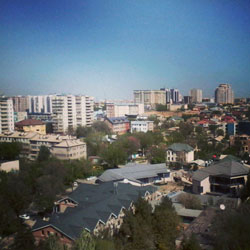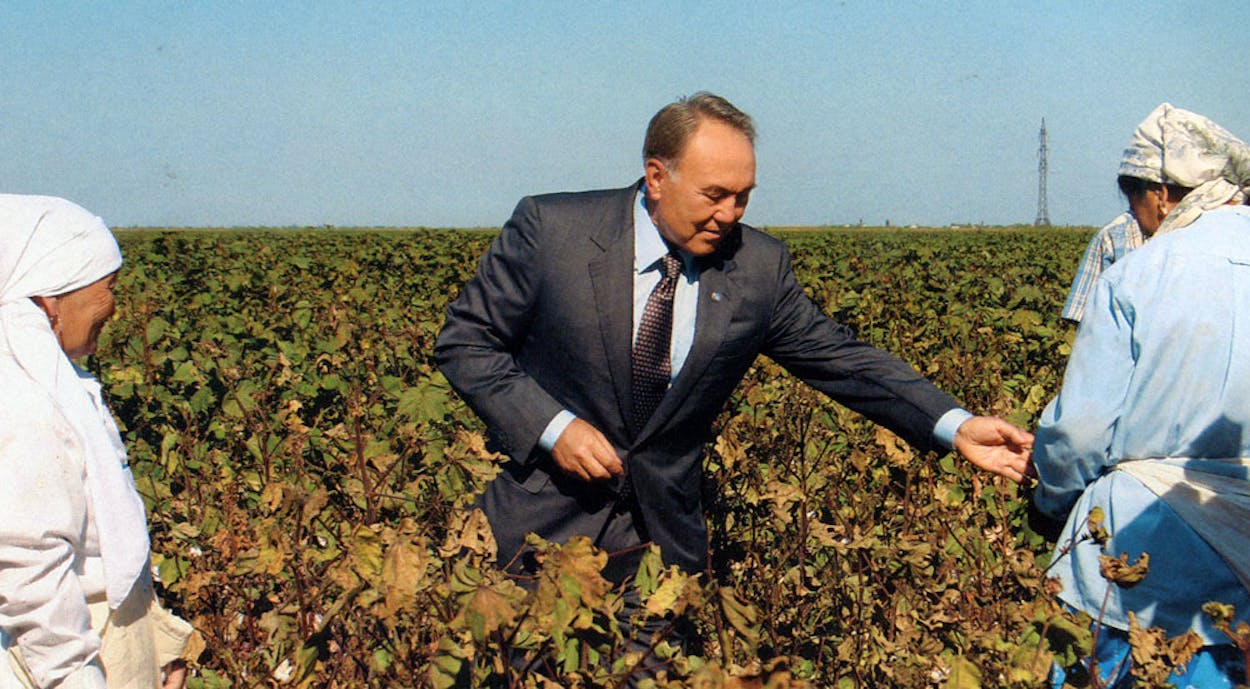“Shymkent—it’s Texas. There are bandits there and here as well,” our Uzbek cab driver explained as he navigated his blue minivan through the chaotic streets of Kazakhstan’s third largest city. Shymkent is the capital of South Kazakhstan Oblast, a state that has been nicknamed “the Texas of Kazakhstan” since Soviet times. Before we got out of our cab, the driver invited us to come over to his house and eat shashlik, barbecued shish kebabs. Southern hospitality, post-Soviet style.
Ask why this area is considered the “Texas” of Kazakhstan and you typically get some variation of the following answer: geography (located in the same south and central part of the country as the Lone Star State), cows (lots), and lawlessness (the Wild West of Kazakhstan!). To be fair, the “Texas of X” construction is one that pops up with some frequency. See Bavaria (“the Texas of Germany”), Mongolia (“the Texas of Asia”), Nigeria (“the Texas of Africa”). And Kazakhstan, with its 30 billion barrels of proven oil reserves, itself has been dubbed “the Texas of Central Asia.” (The analogy might be a bit of a stretch sometimes, but it speaks to the strength of our brand: you’ll never hear “The Oklahoma of X”—no offense to our northern neighbor.)
 I visited Shymkent in early July. Its 620,000 residents live 450 miles from Almaty, Kazakhstan’s former capital, a pleasant, tree-lined city in the shadow of the Tien Shan mountains, and 1000 miles from Astana, that strange, imperial Vegas on the Steppe where President Nursultan Nazarbayev moved the capital in 1997. In its appearance, Shymkent has more in common with Tashkent, the capital of Uzbekistan, just an hour and a half drive to the south, than with Almaty or Astana. This is partly because Shymkent is home to a sizeable minority of ethnic Uzbeks, both those who have recently immigrated and those who have lived in the Shymkent for hundreds of years.
I visited Shymkent in early July. Its 620,000 residents live 450 miles from Almaty, Kazakhstan’s former capital, a pleasant, tree-lined city in the shadow of the Tien Shan mountains, and 1000 miles from Astana, that strange, imperial Vegas on the Steppe where President Nursultan Nazarbayev moved the capital in 1997. In its appearance, Shymkent has more in common with Tashkent, the capital of Uzbekistan, just an hour and a half drive to the south, than with Almaty or Astana. This is partly because Shymkent is home to a sizeable minority of ethnic Uzbeks, both those who have recently immigrated and those who have lived in the Shymkent for hundreds of years.
Hoping to learn a bit more about the similarities between Texans and Shymkenters, I met with Balkhiya Komekbayeva, the 50-something head of South Kazakhstan Oblast’s Department of Language Development, at Del Papa, a popular Italian restaurant in the central part of town. “The people in Shymkent are very temperamental, proud, hard workers, adaptable, and hospitable. And they like to boast a little bit,” Komekbayeva explained to me over the honks from passing cars on Tauke Khan Avenue, Shymkent’s lively main drag. She first heard Shymkent compared to Texas in Soviet times, she said, when she was only 12.
 Komekbayeva reached across the red-checkered tablecloth to hand me a green, hardbound copy of The South—Soul of the Nation, written in Kazakh. While I can speak Russian, I can’t speak Kazakh, so I relied on the glossy picture inserts. Here’s what I gleaned: they grow cotton (we grow cotton), they have snow leopards (we have mountain lions and ocelots), and they have scrubby desert landscapes (we have west Texas). There’s even a poem included in the book that calls the state the Texas of South Kazakhstan.
Komekbayeva reached across the red-checkered tablecloth to hand me a green, hardbound copy of The South—Soul of the Nation, written in Kazakh. While I can speak Russian, I can’t speak Kazakh, so I relied on the glossy picture inserts. Here’s what I gleaned: they grow cotton (we grow cotton), they have snow leopards (we have mountain lions and ocelots), and they have scrubby desert landscapes (we have west Texas). There’s even a poem included in the book that calls the state the Texas of South Kazakhstan.
What’s a Texan’s take on the name? Brooks Frazier, a business development consultant who splits his time between Houston and Kazakhstan, offered one theory he’s developed over his 14 years of visiting the country. “In the Soviet days, the Russians were fairly exposed to Americans in ways that Americans were not exposed to the Soviets,” Frazier said. Westerns were popular, and the “ruleless area, rough people, tough situations” depicted in them, Frazier said, reminded some of South Kazakhstan, so Texas quickly became a slang term to refer to the area.
 While the “Texas” nickname may only date to Soviet times, the differences between South Kazakhstan and the rest of the country go back centuries. Although most Kazakhs were nomadic, those who lived in South Kazakhstan had more sedentary roots. “In Shymkent they adopted the trading style that you would find more in the great Silk Road cities of Bukhara and Khiva, and it was unfamiliar to the nomadic Kazakhs,” Frazier explained. That lingering otherness—and the accompanying distrust—led to the “Texas” nickname, but it wasn’t long before Shymkenters themselves adopted it and made it their own.
While the “Texas” nickname may only date to Soviet times, the differences between South Kazakhstan and the rest of the country go back centuries. Although most Kazakhs were nomadic, those who lived in South Kazakhstan had more sedentary roots. “In Shymkent they adopted the trading style that you would find more in the great Silk Road cities of Bukhara and Khiva, and it was unfamiliar to the nomadic Kazakhs,” Frazier explained. That lingering otherness—and the accompanying distrust—led to the “Texas” nickname, but it wasn’t long before Shymkenters themselves adopted it and made it their own.
Having been told ahead of time about Shymkent’s Texas appellation, I bought $85 in Texas-related souvenirs a few days before my flight. I picked out glossy Texas-flag stickers and “Come and Take It” magnets, as well as a tiny model of the Alamo and a belt buckle bearing the Texas state seal. I felt a bit sheepish about these gifts, having never been the type of Texan to boast about my roots. But when I spoke to a group of students at the American Corner in Shymkent, they couldn’t be more excited to talk about the state. At the end of our discussion, I spread my Texas tchotkes out on a table and they eagerly scooped them up, leaving me wishing I had brought twice as many.
 Afterwards, one of the English teachers in the audience, Yevgeniya Grebenkina, asked me if her students could send me essays in English and I happily agreed. Last week, the first batch arrived in my inbox ellucidating the Texas-Shymkent connection. “In Shymkent people are very fond of meat and it unites us with the Texans.” Mukhtar Raibek wrote. “Texas borders on Mexico. Mexican culture influences Texas culture. Shymkent borders on Uzbekistan. And Uzbek culture influences Kazakh culture,” wrote Olga Sahkarova. But my favorite line came from Roman Grishin, 19: “Our people are so fond of calling Shymkent as the second Texas. So it would be nice if someone in Texas once said ‘Oh yes, today is hot like in Shymkent.’”
Afterwards, one of the English teachers in the audience, Yevgeniya Grebenkina, asked me if her students could send me essays in English and I happily agreed. Last week, the first batch arrived in my inbox ellucidating the Texas-Shymkent connection. “In Shymkent people are very fond of meat and it unites us with the Texans.” Mukhtar Raibek wrote. “Texas borders on Mexico. Mexican culture influences Texas culture. Shymkent borders on Uzbekistan. And Uzbek culture influences Kazakh culture,” wrote Olga Sahkarova. But my favorite line came from Roman Grishin, 19: “Our people are so fond of calling Shymkent as the second Texas. So it would be nice if someone in Texas once said ‘Oh yes, today is hot like in Shymkent.’”
As I write, it’s 99 degrees in Austin. Today is hot like in Shymkent.
Instagram photos by @nemozhan, @sunset_of_shymkent, @olenka_altuhova, and @sonia_smith.







